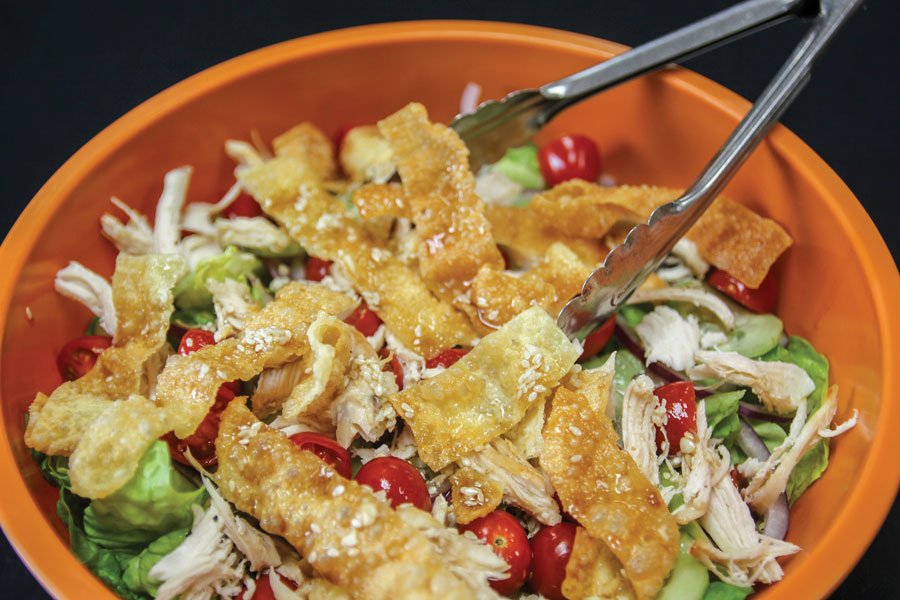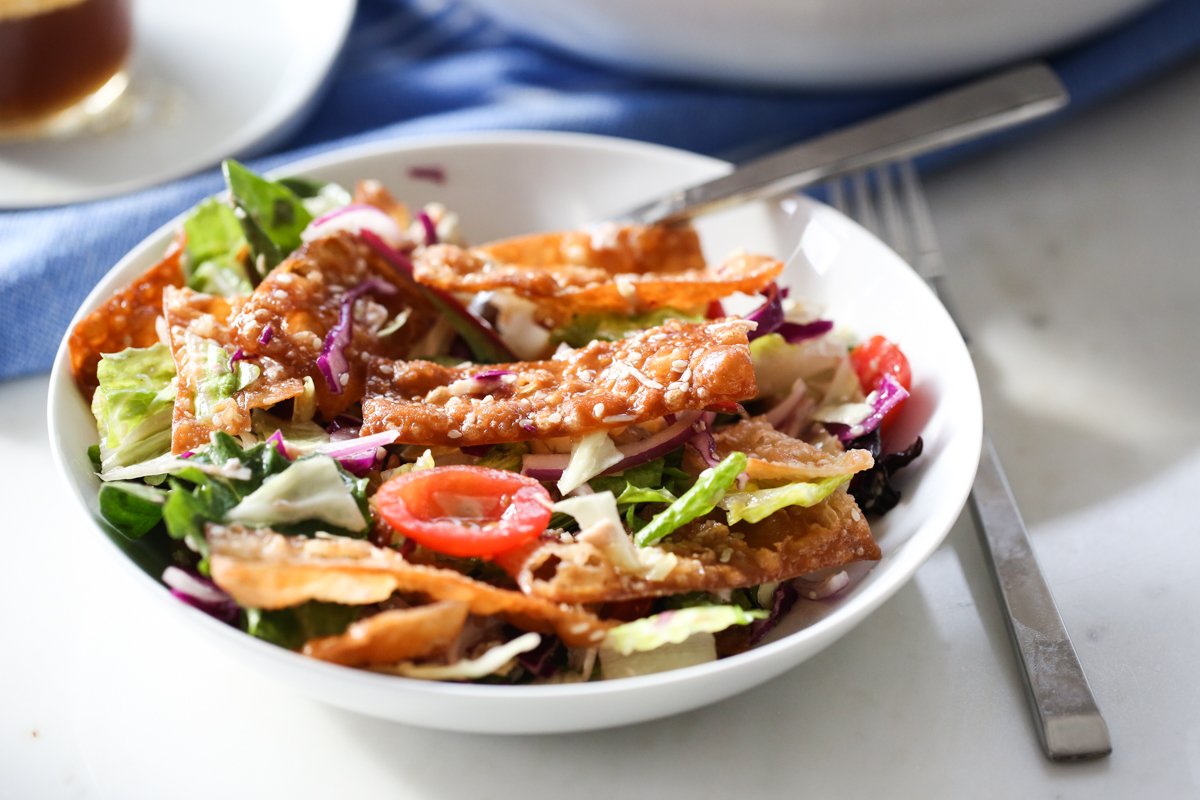Why Choose an Asian Wonton Salad?
Salads often get a bad rap for being bland or boring, but the Asian Wonton Salad flips that narrative on its head. This dish draws inspiration from Asian cuisines, blending the savory, sweet, and tangy elements that make dishes like spring rolls and sesame chicken so irresistible. The star of the show—crispy wonton strips—adds a delightful crunch that contrasts beautifully with tender greens and crunchy vegetables. Tossed in a sesame-ginger dressing, this salad is a symphony of textures and flavors that keeps you coming back for more.
What makes this salad truly special is its balance. It’s light yet satisfying, healthy yet indulgent, and endlessly customizable to suit your taste or dietary needs. Whether you’re craving a plant-based meal, a protein-packed lunch, or a crowd-pleasing potluck dish, the Asian Wonton Salad delivers. Plus, it’s quick to prepare, making it perfect for busy weeknights or last-minute entertaining. Let’s dive into the recipe and discover how to create this culinary masterpiece at home.
The Recipe: Classic Asian Wonton Salad
Below is a comprehensive recipe for a classic Asian Wonton Salad that serves 4 as a main dish or 6 as a side. This recipe is designed to be vibrant, flavorful, and easy to assemble, with a prep time of 10 minutes (assuming pre-fried wonton strips).
Ingredients
For the Salad Base:
- 6 cups mixed greens (romaine, baby spinach, or a spring mix)
- 1 cup shredded red cabbage (for color and crunch)
- 1 cup shredded carrots (for sweetness and texture)
- 1 red bell pepper, thinly sliced (for a pop of color)
- 1 cup shelled edamame, cooked and cooled (for plant-based protein)
- 3 green onions, thinly sliced (for a mild oniony bite)
- ½ cup cilantro leaves, roughly chopped (optional, for freshness)
- 1 cup fried wonton strips (store-bought or homemade, see below)
- ¼ cup toasted sesame seeds (for nutty flavor)
- 1 avocado, sliced (for creaminess, optional)
For the Wonton Strips (if making from scratch):
- 10 wonton wrappers, cut into ½-inch strips
- Vegetable oil, for frying
- Pinch of salt
For the Sesame-Ginger Dressing:
- ¼ cup soy sauce (or tamari for gluten-free)
- 2 tablespoons rice vinegar
- 2 tablespoons sesame oil
- 1 tablespoon honey or maple syrup (for sweetness)
- 1 tablespoon freshly grated ginger
- 1 garlic clove, minced
- 1 teaspoon sriracha or chili garlic sauce (optional, for heat)
- 2 tablespoons water (to thin the dressing)
- 1 tablespoon toasted sesame seeds
Instructions
- Prepare the Wonton Strips (if making from scratch): Heat 1 inch of vegetable oil in a medium skillet over medium-high heat until it reaches 350°F (use a thermometer for accuracy). Carefully add the wonton strips in small batches, frying for 30–45 seconds until golden and crispy. Remove with a slotted spoon and drain on paper towels. Sprinkle with a pinch of salt while hot. Set aside to cool. (Skip this step if using store-bought wonton strips.)
- Make the Dressing: In a small bowl or mason jar, whisk together the soy sauce, rice vinegar, sesame oil, honey, grated ginger, minced garlic, sriracha (if using), water, and sesame seeds until well combined. Taste and adjust seasoning, adding more honey for sweetness or sriracha for spice. Set aside. (The dressing can be made up to 3 days in advance and stored in the fridge.)
- Prep the Vegetables: Wash and dry the mixed greens thoroughly to remove excess water, which can dilute the dressing. Shred the red cabbage and carrots using a box grater or mandoline for uniform pieces. Thinly slice the red bell pepper and green onions. Cook the edamame according to package instructions (usually a quick boil for 3–5 minutes), then cool under cold water. Roughly chop the cilantro, if using.
- Assemble the Salad: In a large mixing bowl, combine the mixed greens, red cabbage, carrots, red bell pepper, edamame, green onions, and cilantro (if using). Drizzle half of the dressing over the salad and toss gently to coat. Add more dressing as needed, reserving some for serving on the side.
- Add the Toppings: Transfer the dressed salad to a large serving platter or individual bowls. Top with fried wonton strips, toasted sesame seeds, and avocado slices (if using). For a stunning presentation, arrange the toppings in distinct sections or sprinkle evenly for a rustic look.
- Serve Immediately: Serve the salad with extra dressing on the side and a pair of tongs or forks for easy serving. The wonton strips are best enjoyed fresh to maintain their crunch, so add them just before serving.

Yield: 4 main servings or 6 side servings
Prep Time: 10 minutes (plus 5 minutes if frying wonton strips)
Total Time: 10–15 minutes
Estimated Calories: ~300–350 kcal per main serving (varies based on dressing and toppings)
Nutritional Benefits of an Asian Wonton Salad
This Asian Wonton Salad is as nourishing as it is flavorful, offering a variety of health benefits from its wholesome ingredients:
- Mixed Greens: Packed with vitamins A, C, and K, greens like romaine and spinach support immune function, skin health, and bone strength. They’re also low in calories, making them a great base for a light meal.
- Red Cabbage: Rich in antioxidants like anthocyanins, red cabbage helps reduce inflammation and supports heart health. Its crunch adds satisfying texture.
- Carrots: High in beta-carotene, carrots promote eye health and boost immunity. Their natural sweetness balances the savory dressing.
- Edamame: A complete plant-based protein, edamame provides fiber, iron, and magnesium, making this salad filling and energizing.
- Sesame Seeds: Loaded with healthy fats, calcium, and antioxidants, sesame seeds support heart health and add a nutty crunch.
- Avocado: Full of monounsaturated fats, avocado promotes satiety and aids in the absorption of fat-soluble vitamins.
- Ginger: Known for its anti-inflammatory and digestive properties, ginger adds a zesty kick to the dressing.
- Soy Sauce: While high in sodium, soy sauce provides umami flavor and small amounts of protein. Opt for low-sodium versions to keep it heart-healthy.
This salad is rich in fiber, which supports digestion, and offers a balance of carbs, protein, and healthy fats to keep you satisfied. It’s naturally vegetarian and can be made vegan by swapping honey for maple syrup. With gluten-free tamari and store-bought gluten-free wonton strips (or omitting them), it’s easily adaptable for gluten-free diets.
Customization Tips for Your Asian Wonton Salad
The beauty of this salad lies in its flexibility. Here are some ideas to tailor it to your preferences or pantry:
- Switch Up the Greens: Try arugula for a peppery bite, kale for a heartier texture, or watercress for a delicate, nutrient-packed base.
- Vary the Veggies: Add sliced cucumbers, snap peas, radishes, or bean sprouts for extra crunch. Roasted sweet potatoes or mushrooms can add warmth and depth.
- Boost the Protein: Toss in grilled chicken, shrimp, tofu, or seared tuna for a heartier meal. For a vegan option, add roasted chickpeas or tempeh.
- Play with Toppings: Swap wonton strips for crushed peanuts, cashews, or crispy chow mein noodles. Add dried cranberries or mandarin orange segments for a sweet-tart twist.
- Adjust the Dressing: For a creamier dressing, blend in a tablespoon of tahini or peanut butter. For a lighter option, reduce the sesame oil and add more rice vinegar.
- Make It Spicy: Amp up the heat with extra sriracha, sliced jalapeños, or a sprinkle of red chili flakes.
- Go Grain-Based: Turn it into a bowl by serving over cooked quinoa, brown rice, or soba noodles for a more substantial meal.
Pro Tips for the Perfect Asian Wonton Salad
To ensure your salad is restaurant-quality, keep these expert tips in mind:
- Fry Wonton Strips with Care: If making wonton strips, fry in small batches to avoid overcrowding, which can lead to soggy strips. Keep the oil at a consistent temperature to ensure even browning.
- Dress Lightly: Start with half the dressing and toss gently to avoid wilting the greens. Serve extra dressing on the side so guests can customize their portions.
- Toast Sesame Seeds: Toasting sesame seeds in a dry skillet for 1–2 minutes enhances their nutty flavor. Watch closely to avoid burning.
- Prep Ahead: Chop vegetables and make the dressing up to a day in advance. Store components separately in airtight containers to keep everything fresh. Fry wonton strips just before serving to maintain their crunch.
- Balance Textures: Aim for a mix of soft (greens, avocado), crunchy (wonton strips, cabbage), and chewy (edamame) elements to keep every bite interesting.
- Presentation Matters: Use a wide, shallow bowl or platter to showcase the salad’s vibrant colors. Arrange toppings thoughtfully for an Instagram-worthy spread.
Asian Wonton Salad Variations
Ready to get creative? Try these delicious variations on the classic recipe:
- Thai-Inspired Wonton Salad: Swap the dressing for a peanut-lime dressing (blend peanut butter, lime juice, soy sauce, and chili paste). Add Thai basil, mint, and mango slices for a tropical twist.
- Miso Wonton Crunch: Incorporate a miso-tahini dressing (miso paste, tahini, rice vinegar, and water) and top with seaweed flakes and pickled ginger for an umami bomb.
- Sesame Chicken Wonton Salad: Add grilled sesame-marinated chicken strips and swap cilantro for fresh mint. Top with crushed peanuts and a drizzle of hoisin sauce.
- Vegan Rainbow Wonton Salad: Use maple syrup in the dressing, add roasted beets and purple sweet potatoes, and top with pomegranate seeds for a colorful, plant-based feast.
Sustainability and Sourcing Tips
To make your Asian Wonton Salad eco-friendly and ethical, consider these tips:
- Shop Local: Source greens, cabbage, and carrots from a nearby farmers’ market to support local growers and reduce transportation emissions.
- Choose Organic: Opt for organic produce to minimize pesticide exposure, especially for greens and bell peppers, which are often heavily sprayed.
- Minimize Waste: Use vegetable scraps (like carrot tops or cabbage cores) to make homemade stock. Compost any inedible scraps.
- Buy in Bulk: Purchase pantry staples like sesame seeds, soy sauce, and rice vinegar in bulk to save money and reduce packaging.
- Support Sustainable Brands: Choose wonton wrappers or store-bought strips from brands that prioritize sustainable sourcing and minimal processing.

Conclusion
The Asian Wonton Salad is more than just a dish—it’s a celebration of bold flavors, vibrant colors, and wholesome ingredients. With its crispy wonton strips, fresh vegetables, and zesty sesame-ginger dressing, this salad is a crowd-pleaser that’s as nutritious as it is delicious. Whether you’re whipping it up for a quick weeknight dinner or impressing guests at a summer barbecue, this recipe delivers on taste, texture, and versatility. So grab your mixing bowl, channel your inner chef, and create a salad that’s as unique as you are. Here’s to crunchy, flavorful meals that nourish both body and soul!

